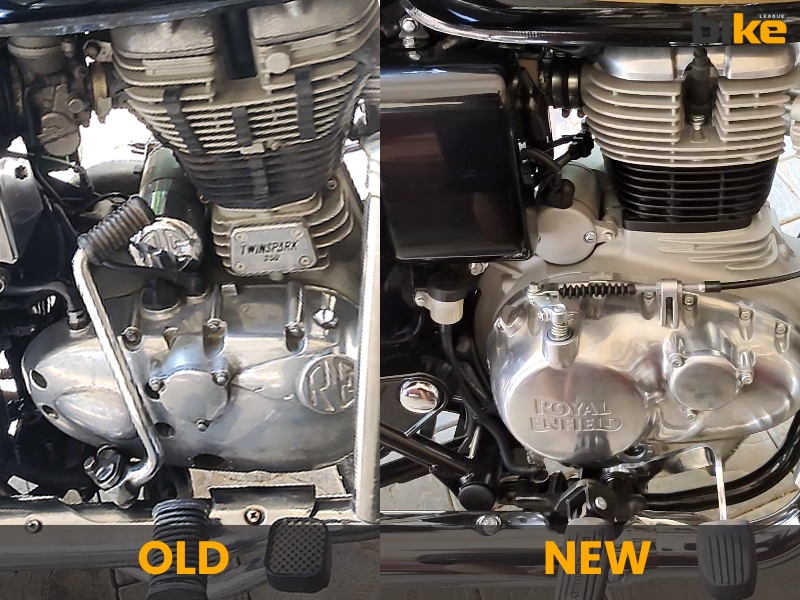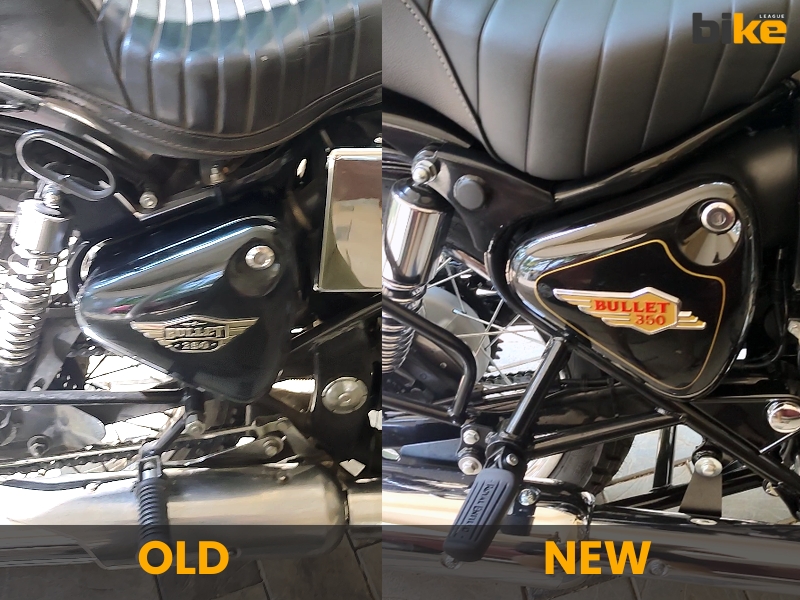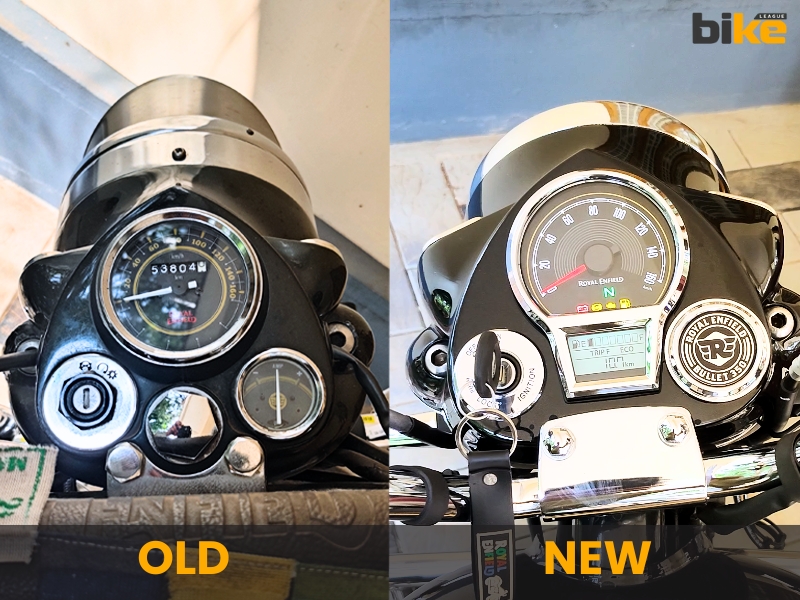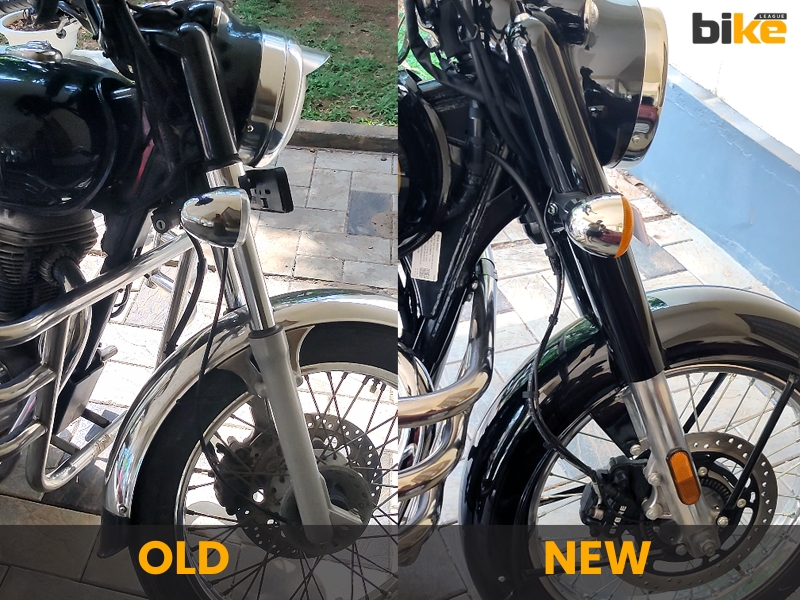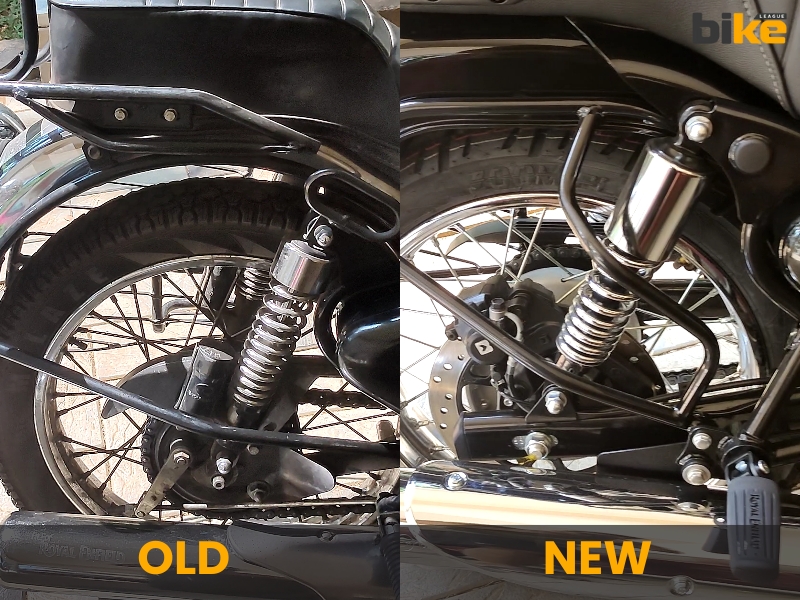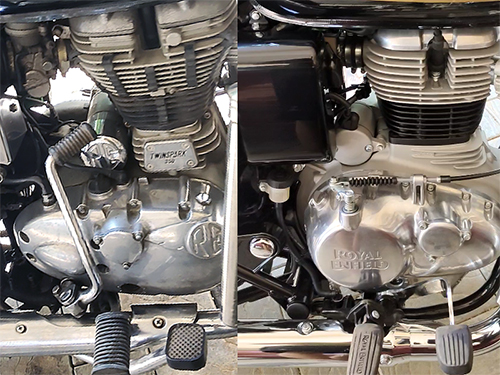
Long story short: There’s been a lot of debate since the new Royal Enfield Bullet 350 came out. People keep asking if it’s better than the old one. Let’s finally clear things up.
Hello everyone, my name is Hiran Narayanan, owner and chief content writer at Bikeleague India. I have been meaning to write an editorial for a while, and inspiration struck after I purchased the new Royal Enfield Bullet 350 a month ago.
I have ridden a Royal Enfield Bullet 350 ES for over six years, covering around 60,000 km. Having experience with both the older and the new Bullet 350 models, it was the right time to share my perspective. In this article, I will compare every aspect of both generations in detail.
Key Takeaways
- The new Bullet 350 has a 349cc, SOHC, 20bhp, 27Nm torque, counterbalanced for fewer vibrations, smoother at high speeds.
- The old Bullet 350 has a 346cc, pushrod UCE, 19bhp, 27 Nm torque, raw vibrations, rugged at high speeds.
- The old Bullet 350 utilised a single downtube frame, lighter but less stable at high speeds. The new Bullet 350 features Twin downtube frame, more stable, better cornering and high-speed control .
- The old Bullet 350 is more balanced, stable in turns, confidence-inspiring, suitable for city and highway use. The new Bullet 350’s Lighter, nimble at slow speeds, but wobbly on turns or bumps at high speeds.
- Vibration levels are minimal in new Bullet 350 due to counterbalancer, refined ride. While on the older Bullet 350 there are higher vibrations and has characteristic Bullet thump.
Comparison between New Royal Enfield Bullet 350 vs old Bullet 350
1. Engine of old & new Royal Enfield Bullet 350
The most significant change in the motorcycle is the engine. The new Royal Enfield Bullet 350 features a smoother, slightly larger engine (349cc) compared to the old one (346cc).
This engine, also found in the Meteor 350 and Classic 350, provides slightly more power: approximately 20 bhp in the new model, compared to 19 bhp in the old. The pulling strength (torque) stays nearly the same at 27Nm. As a result, the ride is smoother and vibrates less than the old Bullet.
In summary, the new Bullet 350 offers a smoother and more powerful ride at higher speeds. At the same time, the old Bullet retains its rugged, classic feel, which long-time fans appreciate. Purists may prefer the older model, but the new model stands out for its improved performance above 60km/h.
2. Fit & Finish
The new Bullet 350 feels better built. The switches, footrests, and other parts feel stronger and fit better. The paint also appears more even and less likely to chip, with a wide range of colour choices. There are also many company accessories available for this model, which are very useful.
Older Bullets sometimes had loose parts, uneven gaps, and paint problems. Still, this roughness gives them a classic charm that some riders like. There are fewer official accessories, so owners often use third-party parts.
3. Electrical System
The old Bullet created a spark to start the engine using a spinning magnet and needed just basic lights and a foot lever to start. The new Bullet 350 utilises a battery and generator to start with the push of a button. There is no foot lever to start it in any new Bullet 350.
The new part-digital display shows both pointer dials and numbers for better information. This includes speed, fuel left, total and trip distance, clock, brake safety light, battery warning, and other valuable things. A USB charger lets you charge devices easily. Older models only showed speed and distance with pointer dials, and sometimes didn’t even have a fuel gauge.
The latest Bullet 350 uses conventional bulbs for the front, rear, and signal lights, rather than modern LED ones. However, the battery does not require maintenance, which is a significant advantage and a standard feature in all new models.
4. Chassis
The old Bullet utilised a simple main support bar, which was less sturdy and made it more difficult to control at high speeds. The new Bullet 350 features two stronger support bars, providing better control and steadiness when turning or riding at high speeds. Older Bullets were less stable at higher speeds, but the new one fixes this problem.
5. Suspension of old & new Royal Enfield Bullet 350
The old Bullet had basic front shocks, which didn’t control bumps well, especially on uneven roads. The back springs could not be adjusted significantly, resulting in a less comfortable ride. Oil-filled shocks didn’t handle bumps as well as gas-filled ones.
In the new Bullet, the thicker front shocks give more control and steadiness, especially when stopping or turning. The back springs can be adjusted, allowing you to set them up for your weight or preferred riding style. This makes the ride smoother and easier to handle.
The new Bullet 350’s gas-filled shocks are superior to the oil-filled ones used previously. Gas-filled shocks handle bumps more effectively, providing a smoother ride.
6. Ride quality & refinement
The old Bullet 350 was more comfortable at slower speeds. Its soft suspension made small bumps less noticeable during slow rides. However, the simple frame and shocks made it wobbly, especially in turns or when travelling at high speeds. The engine also vibrated a lot, which could tire riders on long trips.
The new Bullet 350 is comfortable at any speed. Its stronger frame and improved shocks make the ride smoother, even on uneven roads. The new engine also reduces shaking, making rides much more pleasant.
7. Handling old & new Royal Enfield Bullet 350
The old Bullet 350 is lighter and easier to move slowly. Its thin tyres and simple frame make it easy to manoeuvre in tight spots. But the weaker frame and suspension made it less steady when turning or hitting bumps.
The new Bullet 350’s stronger frame and improved suspension provide you with more control and confidence, even when turning or riding at high speeds.
The discontinued Bullet 350 offered a certain charm with its smoother ride, particularly on highways. The latest Bullet 350 delivers a more balanced and confidence-inspiring riding experience, from cruising to navigating city streets.
8. Braking system
The old Bullet used a disc brake in front and a drum brake at the back, which meant it didn’t stop as well. The back brakes made noise and needed more maintenance. There was a brake safety system (ABS), but it only worked for the front wheel, making it less safe than systems that work on both wheels.
A big improvement in the new Bullet is that it has disc brakes on both wheels. It also comes with a safety brake system for both wheels in some versions, providing customers with more options.
9. Maintenance & Service
In the discontinued Bullet 350, periodic adjustment of valve clearances in the engine is required due to wear and tear. Regular adjustments may be necessary to maintain an optimal air-fuel mixture for smooth operation and optimal fuel efficiency. The chain requires more frequent attention.
Easier access to specific mechanical components due to a less complex design. Parts might be more readily available and potentially cheaper. The more straightforward design might be more approachable for riders who are comfortable with essential mechanical work.
The new Bullet 350 automatically adjusts valve clearances, reducing the need for manual intervention. Fuel injection (EFI) manages the air-fuel mixture, offering a more consistent and hassle-free experience. The sealed chain design requires less frequent lubrication and adjustment.
Modern features like fuel injection require specialised tools or expertise for repairs. With more complex systems, proper maintenance may require relying on trained professionals at authorised service centres.
The discontinued Bullet 350 requires frequent adjustments, but it may be more accessible for DIY maintenance due to its simpler design. Due to the more complex systems, less frequent adjustments in the new Bullet might require relying on service centres for specific maintenance tasks.
10. Color options
The colour variants are now precisely seven, with chrome options available in all six colours. Notably, in the most premium variant, Black Gold, there is no chrome at all. Single-channel ABS is a standard option in all variants.
At the same time, Standard Black, Standard Maroon, and Black Gold dual-channel ABS are standard. The Madras line on the fuel tank is unavailable on military black and military red colour options.
In the old generation, colour options were minimal. Dual-channel ABS was unavailable in colour variants; only single-channel ABS was a standard option.
Pros and Cons of Old Royal Enfield Bullet 350 (UCE)
| Pros | Cons |
|---|---|
| Raw, classic riding feel and distinct engine thump | High vibration levels, especially over longer rides |
| Simpler engine layout, easier for home mechanics and DIY service | Outdated braking—drum on rear, single-channel ABS, less safety |
| Kick starter available (in ES models) for emergencies | Wobbly and less planted at higher speeds or on uneven roads |
| Heavy metal construction and classic charm | Inconsistent paint quality,loose fittings possible |
| Less expensive to buy and maintain spares are cheaper | Minimal official color options or company accessories |
| Straightforward analog meters,fewer electronics to fail | Needs frequent manual valve and chain adjustment |
| Many third-party accessories and parts available | Drum rear brake needs regular attention and may be noisy |
Pros and Cons of New Royal Enfield Bullet 350 (J Series)
| Pros | Cons |
|---|---|
| Smoother,refined J-series engine with fewer vibrations better for long rides | Engine thump less pronounced than the classic model |
| Improved modern chassis offers more stability, confidence, and safety | Lacks kick starter—only self-start option |
| Front & rear disc brakes, ABS on both wheels (in some variants) | Repairs and major servicing require professional help due to complex tech |
| Adjustable, gas-filled rear suspension for superior comfort | Slightly higher maintenance costs, fewer DIY options |
| Semi-digital instrument console: fuel gauge, clock, trip meters, service indicator | Conventional headlight bulbs; no full LED setup |
| Fuel injection, sealed chain, and maintenance-free battery | Pricier than older generation; top variants cost more |
| Wide array of new colors and company accessories | Purists may miss classic look and rugged feel |
| Enhanced build quality & finish, more precise paintwork |
FAQ related to Royal Enfield Bullet 350 (J series) vs Discontinued Royal Enfield Bullet 350 (UCE)
1. Are there differences in vibration levels between the two models?
Yes, there’s a significant difference. The J series engine features a counterbalancer that substantially reduces vibrations, resulting in a smoother ride compared to the UCE engine. The UCE models were known for their characteristic vibrations, which some riders found uncomfortable over long distances.
2. How does the riding comfort compare between the J series and the UCE Bullet 350?
The J series offers a more comfortable riding experience due to its reduced vibrations and improved engine refinement. This enhancement in comfort is often likened to the difference in refinement between riding a truck (UCE) and a sedan (J series).
3. Are there any notable design changes in the J-series Bullet 350?
While the J series Bullet 350 retains a retro-styled design similar to its predecessor, it incorporates modern touches such as a Smiths-style clock and chrome elements. It also features a helpful digital display with a fuel gauge, clock, and two trip meters.
4. How does the build quality compare between the two models?
The J series engines are considered better built than the UCE engines. While the UCE might feel stronger due to its weight and metal construction, the J series offers a more refined and modern design.
5. Is there a difference in the engine architecture between the J series and UCE?
Yes, there’s a significant change. The J-series engine replaces the older pushrod architecture of the UCE with a more modern SOHC (Single Overhead Camshaft) setup, which improves both performance and reliability.
6. How does the overall riding experience differ between the two models?
Riders have praised the J series for its smooth performance and less complicated riding experience. It’s a preferred choice for new riders or those looking for a hassle-free ride. The UCE had its own charm and was known for a more raw and vibration-heavy experience.
7. Are there any significant technological upgrades in the J-series Bullet 350?
Yes, the J series Bullet 350 comes with several technological upgrades. It features a digital display with a fuel gauge, clock, and trip meters. The engine also incorporates modern technology, such as a counterbalancer, to reduce vibration. These features represent Royal Enfield’s commitment to enhancing the riding experience while maintaining the classic appeal of their motorcycles.
Comparison between New Bullet 350 vs Old Bullet 350 – Table
| Feature | New Royal Enfield Bullet 350 | Old Royal Enfield Bullet 350 |
|---|---|---|
| Engine | 349cc, SOHC, 20 bhp, 27 Nm torque, counterbalanced for fewer vibrations, smoother at high speeds | 346cc, pushrod UCE, 19 bhp, 27 Nm torque, raw vibrations, rugged at high speeds |
| Fit & Finish | Stronger build, improved paint quality, better switches, wide color range, official accessories available | Loose-fitting parts, uneven paint at times, minimal accessories, rough but classic charm |
| Electrical System | Self-start, battery & generator, semi-digital console with fuel gauge, trip meters, clock, USB charger, maintenance-free battery | Kick + electric start (in ES), basic analog dials (speed & odo), sometimes lacked fuel gauge, needed more attention |
| Chassis | Twin downtube frame, more stable, better cornering and high-speed control | Single downtube frame, lighter but less stable at high speeds |
| Suspension | Thicker telescopic front forks, gas-filled adjustable rear shocks for smoother ride | Basic front forks, non-adjustable oil-filled shocks, less effective over bumps |
| Ride Quality | Comfortable at all speeds, reduced vibrations, stronger frame and suspension for stability | Comfortable at low speeds, softer suspension, unstable at high speeds, heavy vibrations |
| Handling | More balanced, stable in turns, confidence-inspiring, suitable for city and highway use | Lighter, nimble at slow speeds, but wobbly on turns or bumps at high speeds |
| Braking System | Front & rear disc brakes, options for single-channel and dual-channel ABS | Front disc + rear drum brake, single-channel ABS only, rear brake noisy and less effective |
| Maintenance & Service | EFI with auto valve adjustment, sealed chain, requires service centers due to modern systems | Needs regular valve clearance adjustment, open chain, easier DIY repairs, cheaper spare parts |
| Technology | Modern digital display, SOHC engine, counterbalancer, refined and smoother | Pushrod engine, raw mechanical feel, fewer electronics |
| Colour Options | 7 variants including chrome and premium Black Gold (no chrome), Single & Dual-channel ABS available | Limited options, only single-channel ABS standard |
| Vibration Levels | Minimal due to counterbalancer, refined ride | High vibrations, characteristic Bullet thump |
| Comfort | Smooth suspension, less tiring, sedan-like refinement | Softer suspension at low speeds but truck-like raw experience on long rides |
| Build Quality | Modern, refined, precision finish | Heavier, more rugged, old-school feel |
| Rider Preference | Appeals to new-gen riders (Gen Z & Alpha), comfort-focused, city-friendly | Appeals to long-time fans, traditionalists who love raw thump & DIY maintenance |
Other related articles from Bikeleague India
- Cruising bikes or cruisers – Top 10 under 5 lakhs in India
- Adventure bikes vs Touring bikes which one is the best
- RE Bullet 350
- RE Classic 350
- Royal Enfield Bikes
Our opinion
The discontinued Royal Enfield Bullet 350 embodied a raw, classic riding experience, marked by its trademark “thump.” While charming, comfort, and refinement were not its primary focus. The new Royal Enfield Bullet 350 prioritises comfort and a smoother ride while retaining the iconic silhouette. Stricter emission regulations might slightly subdue the “thump.”
Still, the overall experience caters to a broader range of riders who value heritage and modern features. The ease of repairs and DIY in older bullets is not passed on to the new generation bullet. Additionally, the new Bullet technology is sophisticated, which may impact long hauls in the event of a breakdown.
Conclusion
Younger riders, such as Gen Z and Alpha, may prefer the new Bullet, while many long-time fans from older generations might not. I count myself among the traditionalists. Still, I can’t ignore the new Bullet’s features, comfort, and performance—they make it hard to resist.
There’s a trade-off between the classic engine thump and vintage feel of older Bullets and the updates in the new model. Royal Enfield needs to keep up with changing times and new riders, especially since competitors are adding more advanced features.
If you have any questions, feel free to email us at bikeleague2017@gmail.com. We’re always happy to help. You can also find us on social media for more updates from Bikeleague India.

